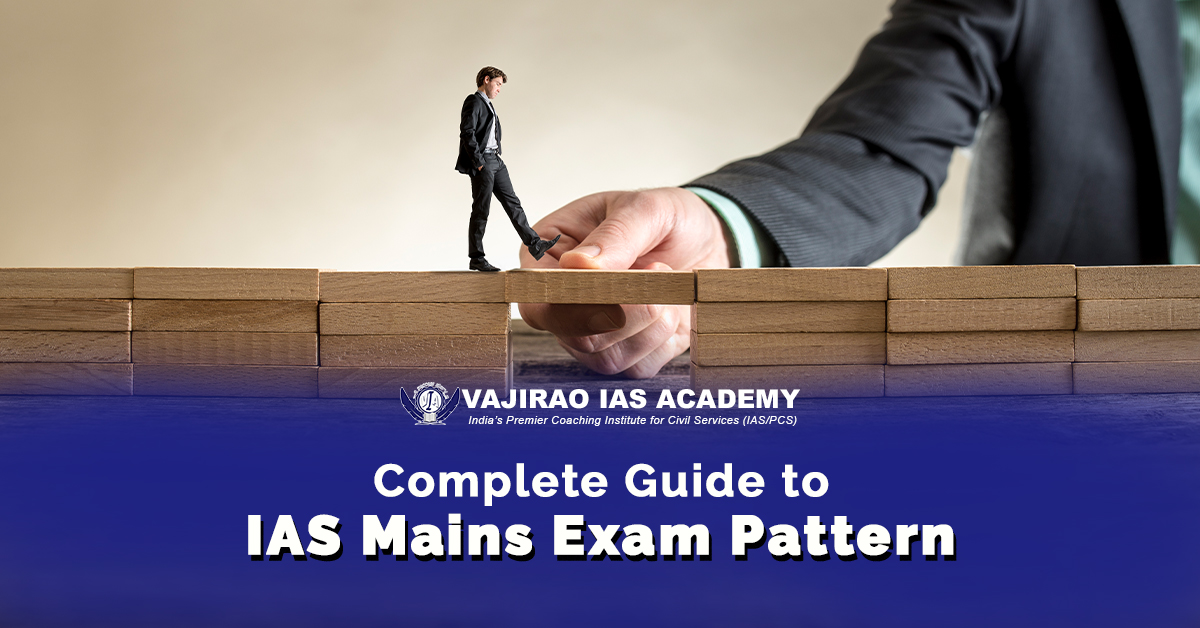Vajirao IAS Academy, the best IAS Coaching Institute in Delhi brings you this comprehensive guide to the IAS Mains Exam Pattern, a must-read for all aspiring Civil Service Officers! This guide aims to provide an in-depth understanding of the exam’s structure and syllabus so that students can adequately prepare themselves for success. It covers topics such as the pattern of the exam, marking schemes, question paper format and tips on how to manage time during the exam.
The IAS Mains Exam is the final step in the Indian Administrative Service (IAS) selection process. It is a highly competitive exam with aspirants from all over India applying for it every year. Preparing for this exam requires an in-depth understanding of the IAS Mains Exam Pattern. This guide will provide students with a comprehensive overview of the exam pattern, including details on subject paper types, question types, marking schemes and time management strategies.
IAS Mains Exam
The IAS Mains Exam is a crucial step for candidates aspiring to become civil servants in India. The exam consists of nine papers, and it is conducted over five days. The first two papers are language papers, which test the candidate’s proficiency in English and an Indian language of their choice. The next four papers are general studies papers, which cover topics such as Indian polity, history, geography, international relations, economics and social issues.
The last three papers are optional subjects chosen by the candidate from a list of disciplines that includes literature, anthropology, law, mathematics and engineering among others. Each paper is of 250 marks with a total weightage of 1750 marks. Additionally, there is also one compulsory essay paper worth 250 marks.
To succeed in this exam pattern candidates should be well-versed with current affairs and have knowledge about India’s history & culture. They must also possess analytical skills to understand complex issues related to society and governance in India which can be acquired through the guidance of the best civil services coaching institutes in Delhi. Proper time management during the examination will play a key role for candidates to score high in each paper as well as overall performance which will determine their position in the final merit list for selection into the civil services cadre.
Exam Structure: Overview
The IAS Mains Exam consists of nine papers in total, with two qualifying papers and seven merit-based papers. The first paper is the language paper which tests the candidate’s proficiency in their chosen Indian language or English. In the second qualifying paper, candidates are tested on their English writing skills, including comprehension and précis writing.
The seven merit-based papers include four General Studies papers, one essay paper, and two optional subject papers. The General Studies Papers cover topics such as Indian Heritage and Culture, Governance issues, International Relations, Ethics and Aptitude. The essay paper requires candidates to write two essays on given topics in three hours.
The optional subject papers test a candidate’s knowledge in a specialized area of study related to their academic background or interests. Candidates must choose two subjects from a list of 48 options provided by UPSC. Each optional subject has two papers for a total of four optional subject papers in total that candidates must complete in the IAS Mains Exam.
Paper Pattern: Descriptive Type
Descriptive Type is an essential aspect of the IAS Mains Exam. The exam consists of nine papers, out of which seven are descriptive in nature. The two objective-type papers are General Studies Paper I and II.
The descriptive type papers assess the candidate’s writing ability, analytical skills, and knowledge on various topics. Each paper carries 250 marks and has a duration of three hours. The seven papers include Essay Writing, English Comprehension & Language, Indian Language Paper (Hindi/Regional), General Studies-I to IV, and Optional Paper-I and II.
To score well in descriptive-type papers, candidates must have strong writing skills as they need to express their thoughts coherently within a given time frame. Also, extensive reading is required for each topic covered in the syllabus to ensure that one can answer questions comprehensively.
Aspirants who wish to qualify for the coveted IAS position must pay attention to all aspects of the exam pattern including the Paper Pattern: Descriptive Type. Consistent practice and careful preparation of each paper’s syllabus content will help them excel in their exams.
Subjects Included: List of Topics
The IAS Mains Exam is an important exam for those aspiring to become civil servants in India. The exam pattern comprises of nine papers that test the candidates’ knowledge and aptitude in various subjects. Here is a list of topics that are included in the IAS Mains Exam:
- General Studies Paper-I: Indian Heritage and Culture, History and Geography of the World and Society.
- General Studies Paper-II: Governance, Constitution, Polity, Social Justice and International Relations.
- General Studies Paper-III: Technology, Economic Development, Bio-Diversity, Environment, Security and Disaster Management.
- General Studies Paper-IV: Ethics, Integrity and Aptitude.
- Essay Writing
- English Language
- Hindi Language
- Optional Subject Paper-I
- Optional Subject Paper-II
Marking Scheme: Weightage Breakdown
The IAS Mains exam is one of the most prestigious competitive exams in India. The exam consists of nine papers, which are divided into two categories: compulsory and optional. Each paper has a different weightage, ranging from 100 to 250 marks. To clear the IAS Mains exam, it’s essential to understand the marking scheme and weightage breakdown.
The first paper in the IAS Mains exam is an essay paper that carries 250 marks. The next two papers consist of General Studies-I and General Studies-II with a weightage of 250 marks each. Thereafter, there are four optional papers carrying a total of 1000 marks (in case you choose only one subject). Finally, there are two language papers carrying a total of 300 marks (one qualifying and one compulsory Indian language).
It’s crucial to understand how much importance should be given to each paper while preparing for the IAS Mains exam. Based on the weightage breakdown mentioned above, candidates can plan their preparation strategy accordingly to score well in each section and increase their overall score in the IAS Mains examination.
Time Management: Tips & Strategies
Effective time management is crucial when it comes to preparing for the IAS Mains Exam. With numerous subjects and topics to cover, it’s easy to get overwhelmed and fall behind schedule. The first step in managing your time is creating a study plan that includes all the subjects you need to prepare for. This way, you can allocate sufficient time for each subject, depending on its weightage.
One of the most effective strategies for managing your time during exam preparation is breaking down large tasks into small, achievable goals. For instance, instead of trying to cover an entire subject in one day, set a goal to complete two or three chapters within a specific timeframe. This will help you stay motivated and focused while making steady progress towards completing your study plan.
Lastly, don’t forget about taking breaks! While it may seem counterintuitive when trying to manage your time effectively, taking regular breaks actually helps improve productivity and focus. Use this time to relax or engage in other activities that bring you joy outside of studying – just be sure not to let them distract you from achieving your goals!
Preparation Tips: Maximizing Score
To maximize your score in the IAS Mains exam, it is important to start preparing well in advance with the best UPSC Coaching Centers in Delhi. Firstly, make sure you are familiar with the exam pattern and syllabus. This will help you understand the type of questions asked and prepare accordingly. Secondly, create a study schedule that allows you to cover all topics thoroughly. Make sure to allot sufficient time for examinations and practice tests.
In addition, it is also helpful to read current affairs regularly as they form an important part of the exam. You can subscribe to newspapers or online news portals for this purpose. Practice writing essays and answer writing on a regular basis as this will improve your speed and accuracy during the actual exam.
Overall, staying consistent with your preparation and focusing on understanding concepts rather than just memorizing them can go a long way in helping you maximize your score in the IAS Mains exam.
Summary: Final Remarks
The IAS Mains Exam Pattern is a comprehensive and challenging test that requires diligent preparation and focus. The exam consists of nine papers in total, with seven being compulsory and two as optional subjects. It is essential to note that the exam has undergone several changes over time, including the introduction of new topics and adjustments to the marking scheme.
To excel in this exam, candidates must develop a well-structured study plan with the guidance of the best IAS Coaching in Delhi that covers all areas of the syllabus thoroughly. They should also practice writing skills regularly since paper evaluation heavily relies on presentation, clarity of thought, and coherence. Additionally, candidates should familiarize themselves with previous year question papers to get an idea of the type of questions asked.
In summary, success in IAS Mains Exam requires hard work, dedication, and persistence. By following these guidelines effectively and efficiently utilizing available resources such as coaching centers or online tutorials can make all the difference when it comes to cracking one of India’s most prestigious exams.




